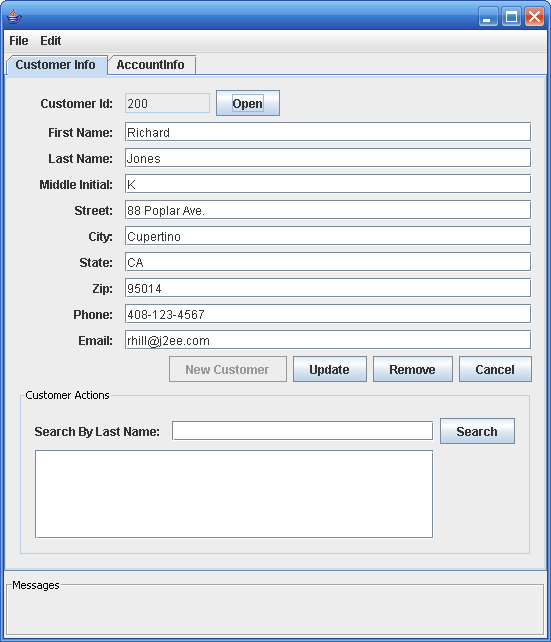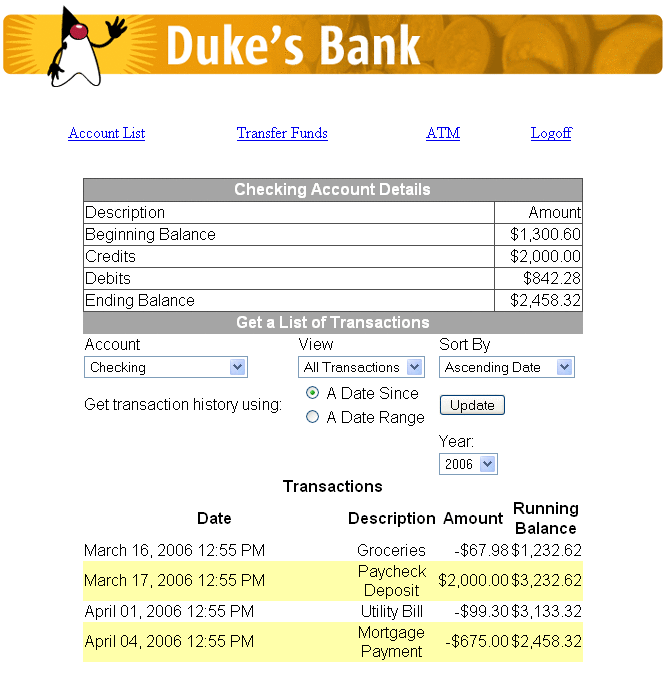To jest stara wersja strony!
CasesJ2EE
Autorzy
Opis projektu
Projekt polega na wyszukaniu aplikacji napisanej w technologii j2ee, zrealizowanej zgodnie z modelem MVC oraz na zapisaniu logiki biznesowej w postaci reguł.
Sprint - e-Protokół
Sprint jest to aplikacja stworzona na potrzeby wydziału EAIiE. Umożliwia obsługę rejestracji użytkowników, tworzenia newsów, zarządzania artykułami, zarządzania kalendarzem. Dodatkowo został stworzony moduł e-Protokół, umożliwiający automatyzację procesu obsługi protokołów w obrębie wydziału EAIiE.
E-protokół, obsługuje przepływ e-protokołów od momentu stworzenia, lub importu poprzez obsługę w dziekanacie, dziekanatach katedr, przez prowadzących zajęcia do momentu zamknięcia, wydruku i eksportu e-protokołu.
Poniżej zaprezentowany jest przepływ biznesowy e-protokołu.

Aplikacja obecnie jest wdrożona na środowisku developerskim. Główne funkcjonalności systemu zostaną wdrożone produkcyjnie w najbliższym czasie, natomiast wdrożenie produkcyjne modułu e-Protokołu przewidziane jest na wrzesień bieżącego roku.
Obecny adres serwisu na środowisku developerskim (dostępny z wewnątrz sieci AGH, bez modułu e-Protokół)
Adres środowiska testowego (zawiera moduł e-Protokół)
Technologia
Aplikacja jest napisana w technologii Java EE 5. Wzorzec MVC został zrealizowany przy użyciu technologii JavaServer Faces 1.2 oraz frameworków Facelets oraz Seam.
Aplikacja jest uruchamiana na serwerze aplikacji JBoss 4.2.2.
Opisanie modułu e-Protokół w postaci reguł
Rule 1:
EProtocolEditForSecretariatBean.editEProtocol.rule1(EProtocolEditForSecretariatBean bean, Boolean isEditingEnabled)
if isEditingEnabled = true
then bean.cancelEditingEProtocol().
Rule 2:
EProtocolEditForSecretariatBean.enableEditingEProtocol.rule1(List assignedLecturersList, Boolean isEditingEnabled)
if assignedLecturersList.length > 0
then isEditingEnabled is false.
Rule 3:
EProtocolEditForSecretariatBean.enableEditingEProtocol.rule2(List assignedLecturersList, Boolean isEditingEnabled)
if assignedLecturersList.length = 0
then isEditingEnabled is true.
Rule 4:
EProtocolEditForSecretariatBean.chooseTheLecturer.rule1(EProtocol selectedEProtocol)
if selectedEProtocol.state = ACCEPTED
then selectedEProtocol.state is NEW.
Rule 5:
EProtocolEditForSecretariatBean.prepareToDeleteTheAssigment.rule1(List lecturersMark, Boolean deletingEnabled)
if markToDelete.length > 0
then deletingEnabled is false.
Rule 6:
EProtocolEditForSecretariatBean.prepareToDeleteTheAssigment.rule2(List lecturersMark, Boolean deletingEnabled)
if markToDelete.length = 0
then deletingEnabled is true.
Rule 7:
EProtocolEditForSecretariatBean.deleteTheAssigment.rule2(List courseUserRels, EProtocol selectedEProtocol)
if courseUserRel.length = 0 and
if selectedEProtocol.state = ACCEPTED
then selectedEProtocol.state is NEW.
Rule 8:
EProtocolEditForSecretariatBean.deleteTheAssigment.rule3(List courseUserRels, List courseUserRelsNotAccepted, EProtocol selectedEProtocol)
if courseUserRel.length > 0 and
if courseUserRelsNotAccepted.length = 0 and
if selectedEProtocol.state = NEW
then selectedEProtocol.state is ACCEPTED.
Rule 9:
EProtocolEditForSecretariatBean.isChangingEnabled.rule1(EProtocol selectedEProtocol, Boolean changing)
if selectedEProtocol.state = CLOSED
then changing is true.
Rule 10:
EProtocolEditForSecretariatBean.isChangingEnabled.rule2(EProtocol selectedEProtocol, Boolean changing)
if selectedEProtocol.state != CLOSED
then changing is false.
Rule 11:
EProtocolEditForLecturerBean.acceptEProtocol.rule1(CourseUserRel rel, Boolean isAcceptedByLecturer)
if rel.state != ACCEPTED
then rel.state is ACCEPTED, isAcceptedByLecturer is true.
Rule 12:
EProtocolEditForLecturerBean.acceptEProtocol.rule1(CourseUserRel rel, Boolean isAcceptedByLecturer)
if rel.state = ACCEPTED
then isAcceptedByLecturer is true.
Rule 13:
EProtocolEditForLecturerBean.acceptEProtocol.rule2(List courseUserRels, EProtocol selectedEProtocol)
if courseUserRel = 0
then selectedEProtocol.state is ACCEPTED.
Rule 14:
EProtocolEditForLecturerBean.acceptEProtocol.rule3(List courseUserRels, List courseUserRelsNotAccepted, EProtocol selectedEProtocol)
if courseUserRel.length > 0 and
if courseUserRelsNotAccepted.length = 0
then selectedEProtocol.state is ACCEPTED.
Rule 15:
EProtocolEditForLecturerBean.unAcceptEProtocol.rule1(CourseUserRel rel, Boolean isAcceptedByLecturer, EProtocol selectedEProtocol)
if selectedEProtocol.state = ACCEPTED
then selectedEProtocol.state is NEW, rel.state is NEW, isAcceptedByLecturer is false.
Rule 16:
EProtocolEditForLecturerBean.addMarkDateType.rule1(Mark addingMark, Utils util)
if addingMark.date.isSet() = false
then addingMark.date is util.getFormattedNowDate().
Rule 17:
EProtocolPrintBean.unlockEProtocol.rule1(EProtocol eProtocol, List courseUserRelsNotAccepted)
if eProtocol.state = CLOSED and
if courseUserRelsNotAccepted = 0
then eProtocol.state is ACCEPTED.
Rule 18:
EProtocolPrintBean.unlockEProtocol.rule2(EProtocol eProtocol, List courseUserRelsNotAccepted)
if eProtocol.state = CLOSED and
if courseUserRelsNotAccepted > 0
then eProtocol.state is NEW.
Rule 19:
EProtocolPrintBean.isClosed.rule1(EProtocol eProtocol, Boolean isClosed)
if eProtocol.state = CLOSED
then isClosed is true.
Rule 20:
EProtocolPrintBean.isClosed.rule2(EProtocol eProtocol, Boolean isClosed)
if eProtocol.state != CLOSED
then isClosed is false.
Rule 21:
EProtocolStudentListBean.prepareToDeleteStudent.rule1(List studentMarks, Boolean isDeleteEnabled)
if studentMarks.length > 0
then isDeleteEnabled is false.
Rule 22:
EProtocolStudentListBean.prepareToDeleteStudent.rule2(List studentMarks, Boolean isDeleteEnabled)
if studentMarks.length = 0
then isDeleteEnabled is true.
Rule 23:
EProtocolStudentListForCourseBean.prepareToDeleteStudent.rule1(List studentMarksForCourse, Boolean isDeleteEnabled)
if studentMarksForCourse.length > 0
then isDeleteEnabled is false.
Rule 24:
EProtocolStudentListForCourseBean.prepareToDeleteStudent.rule2(List studentMarksForCourse, Boolean isDeleteEnabled)
if studentMarksForCourse.length = 0
then isDeleteEnabled is true.
Duke's Bank
Jest to case study zastosowania technologii Java EE 5 do stworzenia przykładowego systemu bankowości elektronicznej.
System wyposażony jest w interfejs web, w którym klienci banku mogą zlecać przelewy oraz przeglądać historię transakcji. Pracownicy banku posiadają dostęp do systemu poprzez klienta desktop, w którym mogą zarządzać kontami i użytkownikami.
Architektura aplikacji
Aplikacje klienckie
| Klient web | Klient desktop |
 |  |
Technologia
Aplikacja jest napisana w technologii Java EE 5. Warstwa prezentacji została zrealizowana zgodnie z wzorcem MVC (JavaServer Faces 1.2). Aplikację uruchomiliśmy na serwerze aplikacji GlassFish V2.
Reguły
Rule 1:
AccountController.createAccount(AccountDetails details, Long customerId, UserPrincipal userPrincipal)
if userPrincipal = 'bankAdmin'
and !isEmpty(details.type)
and !isEmpty(details.description)
and !isEmpty(details.beginBalanceTimeStamp)
and exists(cusomerId)
then account is Account(details), persist(account), add(customerId, account).
Rule 2:
AccountController.removeAccount(Long accountId, UserPrincipal userPrincipal)
if userPrincipal = 'bankAdmin'
then remove(accountId).
Rule 3:
AccountController.addCustomerToAccount(Long customerId, Long accountId, UserPrincipal userPrincipal)
if userPrincipal = 'bankAdmin'
and exists(customerId)
and exists(accountId)
then add(customerId, accountId).
Rule 4:
AccountController.removeCustomerFromAccount(Long customerId, Long accountId, UserPrincipal userPrincipal)
if userPrincipal = 'bankAdmin'
and exists(customerId)
and exists(accountId)
then remove(customerId, accountId).
Rule 5:
AccountController.getAccountsOfCustomer(Long customerId, List<AccountDetails> accountDetails)
if exists(customerId)
then accountDetails is selectAccountByCustomer(customerId).
Rule 6:
AccountController.getCustomerIds(Long accountId, List<Long> customers)
if exists(accountId)
then customers is selectAccountCustomers(customerId).
Rule 7:
AccountController.getDetails(Long accountId, AccountDetails accountDetails)
if exists(accountId)
then accountDetails is selectAccount(accountId).
Rule 8:
CustomerController.createCustomer(CustomerDetails details, UserPrincipal userPrincipal)
if userPrincipal = 'bankAdmin'
and !isEmpty(details.firstName)
and !isEmpty(details.lastName)
then customer is Customer(details), persist(customer).
Rule 9:
CustomerController.removeCustomer(Long customerId, UserPrincipal userPrincipal)
if userPrincipal = 'bankAdmin'
and exists(customerId)
then remove(customerId).
Rule 10:
CustomerController.getDetails(Long customerId, CustomerDetails customerDetails)
if exists(customerId)
then Customer(customerDetails) is selectCustomer(customerId).
Rule 11:
CustomerController.getCustomersOfAccount(Long accountId, List<CustomerDetails> customerDetails)
if exists(accountId)
then account is selectAccount(accountId), Customer(customerDetails) is account.customers.
Rule 12:
CustomerController.getCustomersOfLastName(String lastName, List<CustomerDetails> customerDetails, UserPrincipal userPrincipal)
if userPrincipal = 'bankAdmin'
and !isEmpty(lastName)
then Customer(customerDetails) is selectCustomerByName(lastName).
Źródła i dokumentacja
Podsumowanie



